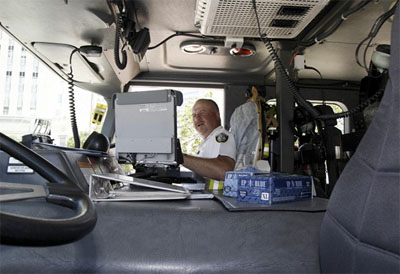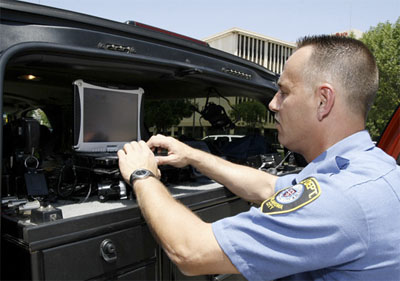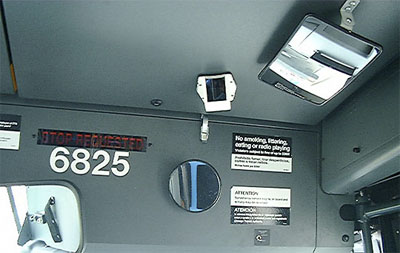July 17, 2008
By JOSHUA BROCKMAN
While some cities have seen their dreams of providing wireless Internet access for all fade, others have forged ahead with wireless networks for an altogether different purpose: surveillance.
Municipal surveillance is no longer confined to isolated street corners. Cities are mapping out vast wireless zones to create safety nets. Oklahoma City just rolled out the world’s largest municipal network, linking hundreds of video surveillance cameras installed across the city. Such networks also extend to public transportation: Chicago has installed the largest network of bus surveillance in the U.S., with cameras on its entire fleet of more than 2,100 buses.

Oklahoma City Battalion Chief Glenn Clark uses a laptop to obtain information using the city’s Wi-Fi network. Police officers and firefighters are able to view real-time images from hundreds of cameras located throughout the city, even if they are far from those locations. Zach Nash/City of Oklahoma City.
A few years ago, many cities plunged head-first into providing free wireless to the masses — especially to low-income communities — as a way of bridging the digital divide and marketing themselves to Internet startups. That didn’t pan out so well in Philadelphia, which saw its much-publicized partnership with Earthlink collapse last year after the Internet service provider decided to exit the municipal wireless business.
Today, public safety is the “largest and most successful sector” in the municipal wireless market, according to MuniWireless.com, a Web site devoted to tracking wireless broadband projects and technologies. Its 2007 state of the market report found that 75 percent of cities and towns with active or planned wireless networks were using them for public safety purposes. That represents a 10 percent increase from 2006.
The Largest Municipal Network
Oklahoma City completed its 555-square-mile municipal Wi-Fi network in June. The $5 million system, which the city paid for with sales taxes and improvement funds, created a network of hundreds of cameras that enable police officers and firefighters to view real-time images of locations throughout the city, even if they are far from those locations.
“What differentiates this is you have over 300 cameras in one central system that’s available to anyone, anywhere that’s authorized,” says Mark Meier, the director of information technology for Oklahoma City.
The system also extends the virtual reach of Oklahoma City’s police department, with cameras on high-risk facilities and highly trafficked parts of the community, including arenas, streets and dense gathering spots for social services, Meier says.
“It’s being used to try to provide additional security proactively,” he explains. “Conceptually, it is part of the evidentiary process that would allow us to establish what crime occurred, who did it and what action is appropriate.”

Oklahoma City Fire Capt. Jim Kruta accesses the city’s Wi-Fi network from a mobile fire unit. Zach Nash/City of Oklahoma City.
The Oklahoma City Police department has equipped its fleet of close to 700 vehicles with laptops to access the network. “Any functions that you’d have in the office, you’d have in the car,” says Lt. Wade Gourley, who supervises the department’s information technology team. The system enables officers in the field to receive and transmit data-intensive information, including photographs. Training is ongoing, but the goal is for every officer to be able to access the system, Gourley says.
Firefighters will be able to use the system to determine the location of water hydrants and to access building floor plans and hazardous material information while they’re traveling to the scene of a fire or accident.
The network also is used by city workers to access more than 150 software applications remotely. For now, however, there is no public access to the Internet through the network. Meier says a dedicated channel exists for that, but it has yet to be turned on.
Cameras, Cameras Everywhere
The process of networking cameras has been gaining momentum in cities large and small. But proposals to mimic London’s vast network of cameras, known as the Ring of Steel, have failed in places like New York City, even when such efforts are aimed at easing congestion by catching cars that are driving in bus lanes. In April, Washington, D.C., Mayor Adrian Fenty proposed that the city connect more than 5,000 closed-circuit cameras into a vast single network.
Chicago already has several hundred cameras installed in its central business district. The cameras are part of a wireless network that the city was able to build using $35 million in funding from a grant from the Department of Homeland Security, says Jim Argiropoulos, acting executive director of the city’s Office of Emergency Management and Communications (OEMC).
“Our intent is to have wireless coverage throughout Chicago at some point in time,” he says.
The video system in Chicago permits the OEMC to access cameras operated by sister agencies, including the Chicago Transit Authority and Chicago Public Schools. It can also tap into video feeds from the private sector, such as the Building Owners and Managers Association, a group of owners that run some of the more notable buildings in Chicago, including the Sears Tower.
As Chicago works to expand its wireless network across the 232-square-mile city, it is also “pushing the edge” of this technology by controlling a network of cameras from a satellite to provide a “synergistic view of what’s happening,” Argiropoulos says.
When asked about the potential for abusing this system to violate people’s privacy, he said video, which is recorded around the clock, is archived for 30 days before being destroyed.
“The surveillance network is all in the public view,” Argiropoulos says. “There’s nothing that we can see that you can’t see while you’re having your lunch, eating your turkey sandwich on a park bench.”
Surveillance On Buses
IBM designed the surveillance networking system for the Chicago Transit Authority. Each of the city’s more than 2,100 buses has been retrofitted with up to seven cameras to monitor and record activities. Not all of the buses are networked at this point: The CTA says it is testing it on two bus routes. The installation will likely be completed by year end, says Michael Sutherland, a member of IBM’s digital video surveillance security and privacy group.
Once on the network, each bus effectively becomes a wireless hot spot, with transmitters and receivers connected to the surveillance cameras. Using laptops that are networked through antennas, Metro transit police and supervisor vehicles can tap into real-time video from inside the bus when they are within a range of several blocks. City command centers may also access the real-time stream when a bus is near a CTA wireless hot spot, Sutherland says.
Video from each bus is stored on a digital video recorder, or DVR, onboard. If an incident occurs, drivers press a button to mark the video, so that the section of video will be saved for scrutiny. Footage can be burned onto a disc later or transferred wirelessly over CTA’s network.

A surveillance camera on a Chicago Transit Authority bus. Chicago has the largest network of bus surveillance in the U.S., with cameras on its entire fleet of more than 2,100 buses. Chicago Transit Authority.
This high-tech security system includes a real-time bus tracking system that enables people to check a Web site to see if their bus is running on schedule. The CTA says this service now is available for 67 of its 153 routes. But the system doesn’t allow commuters to surf the Web — a feature many cities are exploring as a magnet to draw more people to mass transit.
“It has not been developed as an open architecture because of the security requirements,” Sutherland says.
Since November 2006, New York City has also been testing a wireless video surveillance system on buses in Manhattan, with the goal of expanding the system to all buses in the network, a spokesman for MTA New York City Transit says. The cameras record the images to a DVR. There is no wireless access for commuters. For the past 18 months, the city has also been testing a GPS program that tracks buses along their routes and has the capacity to send that information to screens at certain bus stop shelters and to the MTA Web site.
Do They Make The Public Safer?
The growth of public safety surveillance networks has raised questions about those systems’ effectiveness in fighting crime, as well as privacy concerns.
“Increasingly, video surveillance is becoming pervasive. It’s being connected to central locations,” says Barry Steinhardt, the director of the ACLU Technology and Liberty Program.
Because closed-circuit TV, or CCTV, networks are widespread in London and throughout England, they provide some of the best examples for analysis. In 2005, the British government’s Home Office, which is akin to the Department of Homeland Security in the U.S., studied 14 CCTV systems across England and concluded that “most systems revealed little overall effect on crime levels.”
In June, the British government raised new questions about video surveillance in a report by the British Home Affairs Committee, a committee that examines policies of the Home Office. The committee recommended that the Home Office do further research about whether video surveillance deters crime “before allocating funds or embarking on any major new initiative.”
Concerns About Potential Abuse
Only preliminary studies have been conducted in the United States. An analysis of those studies by the ACLU concludes that “video surveillance systems in the U.S. show little to no positive impact on crime.” The ACLU examined independent studies conducted in the U.S. and abroad from 2000 to ’08.
“The surveillance cameras are virtually worthless as a crime-fighting device,” the ACLU’s Steinhardt says. “They are certainly not worth the expenditure.”
Beyond the debate over the effectiveness of video surveillance as a crime-fighting tool, the ACLU has raised concerns about the potential for abuse in a variety of ways — from criminal or personal use of surveillance systems, to discriminatory targeting and voyeurism. The ACLU says video surveillance systems lack an adequate system of checks and balances and that their presence has a “chilling effect” on public life.
U.K.-based Privacy International, along with the U.S.-based Electronic Privacy Information Center, has published annual surveys on global surveillance for more than a decade. Privacy International’s 2007 report ranked the U.S. as the worst country in the democratic world when it comes to putting laws on the books to protect privacy and enforcing them; it classified America as a country where surveillance is “endemic.”
Consumer Benefits
Still, analysts say the construction of vast wireless networks has potential upsides for consumers beyond the safety enhancements that public officials point to.
For example, traffic lights could be networked to accommodate rush-hour patterns. And if cities offered Internet access on mass transit, that could draw commuters out of their cars in heavily trafficked transportation corridors, says Eric Dentler, a wireless product specialist for Cisco Systems Inc.
There are also environmental and safety benefits from applications such as automatic water- and electric-meter reading — which eliminates the need to send people into the field with vehicles to read meters.
In 2004, the city of Corpus Christi, Texas, implemented wireless automated gas- and water-meter readings after a meter reader was badly mauled by pit bulls during a house visit. Today, the city uses its wireless network to read about 65,000 meters at residences and businesses — nearly half of those in the city, says Michael Armstrong, chief information officer for the city.
And while privacy concerns are real, Sally Cohen, an analyst with Forrester Research, says residents of a city or community stand to gain from the presence of a municipal network that connects police, fire and emergency responders. It allows for a quick response to incidents, including helping to find the easiest route to a location.
The Challenge Of Wireless Cities: Who Pays?
Several cities that envisioned creating wireless networks with the goal of free Internet access for all have been stung by partnerships with the private sector.
Municipal wireless is “a market that is still trying to figure itself out,” says Sally Cohen, an analyst for Forrester Research. A number of cities are trying to learn from “failed deployments.”
That includes Philadelphia, where the promise of a $30 million wireless broadband network was heavily marketed by Earthlink until it decided to exit the municipal wireless business in the third quarter of 2007.
In June, a local group of investors took over the Earthlink infrastructure in Philadelphia, and the city said it still plans to provide free wireless access to all of its residents.
Earthlink isn’t alone in exiting the municipal wireless market. In June, MetroFi, a California-based provider of free wireless Internet service, pulled out of its operations in Naperville, Ill., and the company’s Web site indicates that it will discontinue its services in Portland, Ore., as well.
“The main thing that we’ve learned is you can’t just build these things for free and expect people to use them,” Cohen says. Successful networks, she says, are typically ones where someone is paying. And in most cases, that someone isn’t consumers but a city or a city’s public safety agency, local businesses or a university.
But the economic downturn is hurting some cities’ grand plans for wireless coverage.
Falling real estate prices translate into less tax revenue collected, says Esme Voss, the founder of MuniWireless.com. Meanwhile, smaller towns, especially those in rural areas, are likely to continue to build networks largely as a means of attaining broadband coverage.
Those cities still looking to offer wireless access to the public are also shifting away from “dreams of ubiquitous coverage,” says Eric Dentler, wireless product specialist for Cisco Systems Inc.
“A handful of towns and cities have networks up and running and [are] planning to expand. But there’s many more in the queue now looking at the new and improved approach — the notion of broadband corridors or hot zones, instead of complete county or citywide [coverage],” he says.
© NPR
